|
Behind the Eight Ball
by
Bob Brooke
 During
the reign of Queen Elizabeth I of England, the game of billiards had
moved indoors to a wooden table with green cloth to simulate grass and a
simple border around the edges. The term "billiard" came from the French
for either the word "billart," one of the wooden sticks, or "bille," a
ball. Since the early 19th century, it has been known as the "Noble Game
of Billiards," but in fact all sorts of people played the game from its
beginning. In 1600, Shakespeare mentioned it in his play "Antony and
Cleopatra." During
the reign of Queen Elizabeth I of England, the game of billiards had
moved indoors to a wooden table with green cloth to simulate grass and a
simple border around the edges. The term "billiard" came from the French
for either the word "billart," one of the wooden sticks, or "bille," a
ball. Since the early 19th century, it has been known as the "Noble Game
of Billiards," but in fact all sorts of people played the game from its
beginning. In 1600, Shakespeare mentioned it in his play "Antony and
Cleopatra."
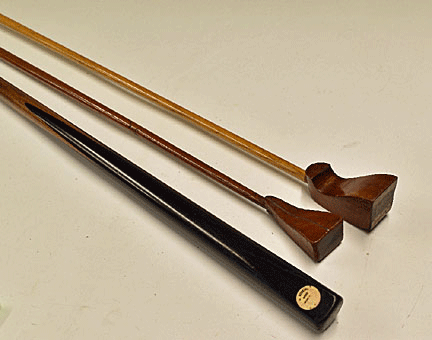 When
players brought the game indoors, they shoved the balls rather than
struck them with wooden sticks called maces. The cue stick didn’t appear
until the late 17th century. When the ball lay near a rail, the mace
didn’t work because of its large head. Players then would turn the mace
around and use the end of its handle to strike the ball. The handle was
called a "queue" meaning "tail" from which came the word "cue." For a
long time, the rules dictated that only men could use the cue. Women had
to use only the mace because people felt they were more likely to rip
the cloth with the sharper cue. When
players brought the game indoors, they shoved the balls rather than
struck them with wooden sticks called maces. The cue stick didn’t appear
until the late 17th century. When the ball lay near a rail, the mace
didn’t work because of its large head. Players then would turn the mace
around and use the end of its handle to strike the ball. The handle was
called a "queue" meaning "tail" from which came the word "cue." For a
long time, the rules dictated that only men could use the cue. Women had
to use only the mace because people felt they were more likely to rip
the cloth with the sharper cue.
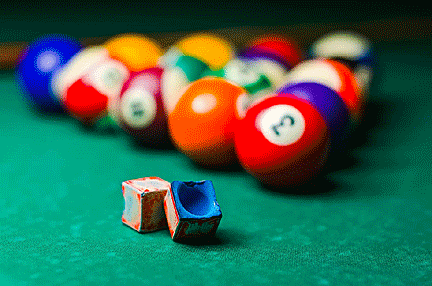 At
some point, a player used chalk to increase friction between the
billiard ball and the cue stick. Performance improved dramatically,
There are four distinct shapes in various colors---. e: square, round,
triangular and wafer. The square variety is by far the most common. The
earliest chalk was white, but the majority today is green or aqua to
match the felt on the tables. At
some point, a player used chalk to increase friction between the
billiard ball and the cue stick. Performance improved dramatically,
There are four distinct shapes in various colors---. e: square, round,
triangular and wafer. The square variety is by far the most common. The
earliest chalk was white, but the majority today is green or aqua to
match the felt on the tables.
Early cues typically varied in length between 54 and 57 inches for pool,
and between 60 inches and longer for billiards. The finer cues were
normally four times more expensive than the common "house cue," reaching
as high as $13 for a tournament-trophy quality model. Around the turn of
the 18th century, the leather cue tip appeared. This allowed a player to
apply side-spin, topspin, or even backspin to the ball. All
billiard/pool cues used to be one single shaft until the two-piece cue
arrived in 1829.
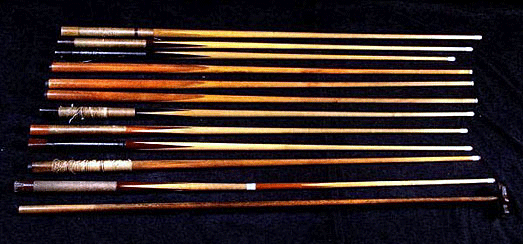
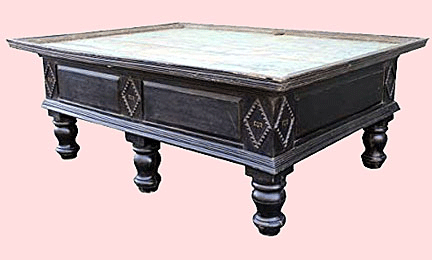 Billiard/pool
tables originally had flat walls for rails. Their only function was to
keep the balls from falling off the table. Players originally called
them "banks" because they resembled the banks of a river. They soon
discovered that the balls could bounce off the rails and began
deliberately aiming at them, and thus the "bank shot" was born. This is
where the billiard ball is hit toward the rail with the intention for it
to rebound as part of the shot. Billiard/pool
tables originally had flat walls for rails. Their only function was to
keep the balls from falling off the table. Players originally called
them "banks" because they resembled the banks of a river. They soon
discovered that the balls could bounce off the rails and began
deliberately aiming at them, and thus the "bank shot" was born. This is
where the billiard ball is hit toward the rail with the intention for it
to rebound as part of the shot.
Wood made up the bed of a billiard table until around 1835, when slate
became popular due to its durability for play and the fact that it
wouldn't warp over time. As for the size of billiard tables, a
two-to-one ratio of length to width became standard in the 18th century.
Before then, there were no fixed table dimensions. By 1850, the billiard
table had essentially evolved into its current form.
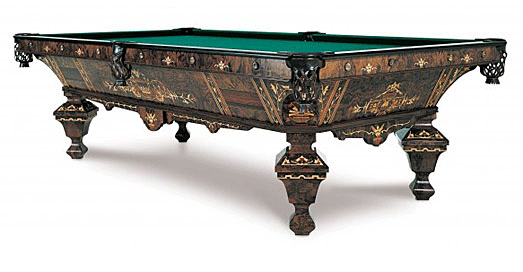
The game of billiards has had many variants. Players referred to a table
without pockets as a "billiard table," while those with pockets were
called "pocket billiard" tables. The term "carom table" was used in the
early days of the sport to denote a billiard table without pockets. To
carom meant to strike two balls at the same time with the white cue
ball.
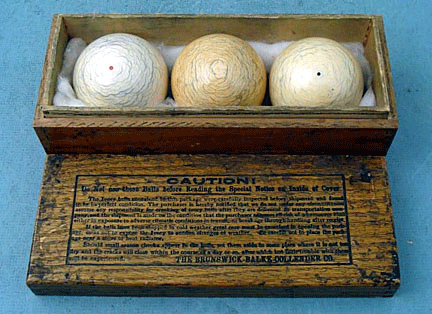 The
sizes of billiard balls ranged from one inch for children's tables, to
2˝ inches in pocket billiard balls, to as large as 2 3/4 inches in the
carom variety. The most common material used was clay. And although
manufacturers tried many other concoctions, they eventually settled on
some type of composition resembling clay. Celluloid balls first appeared
in the late 1800s and proved to be the best substitute for ivory
available at the time. While the makers of clay balls The
sizes of billiard balls ranged from one inch for children's tables, to
2˝ inches in pocket billiard balls, to as large as 2 3/4 inches in the
carom variety. The most common material used was clay. And although
manufacturers tried many other concoctions, they eventually settled on
some type of composition resembling clay. Celluloid balls first appeared
in the late 1800s and proved to be the best substitute for ivory
available at the time. While the makers of clay balls
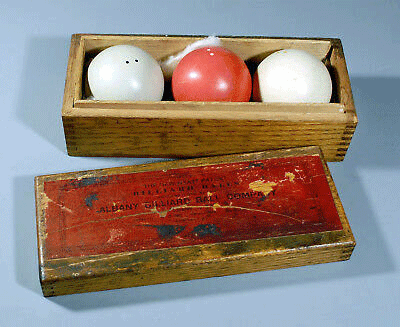 claimed
that the celluloid balls occasionally exploded upon contact, this wasn’t
true. What they did do was shatter during cold weather when left
overnight in poorly heated pool rooms. claimed
that the celluloid balls occasionally exploded upon contact, this wasn’t
true. What they did do was shatter during cold weather when left
overnight in poorly heated pool rooms.
Although clay, ivory, and numbered balls were available for over 150
years, the basic appearance of early billiard cues stood unchanged for
much longer than that. Of the more than 150 independent billiard table
manufacturers from the early to late 19th century, only a handful were
in business for more than a few years. Many combined forces to improve
sales and often bought out competitors.
The Origin of the Pool Hall
The words `pool hall' conjure up a very different image than `billiard
parlor,' but both places provide today's collectors and pool-playing
enthusiasts with plenty of options. Many an 18th and 19th century
ballroom shared its beautiful parquet floor with a stunning, highly
carved and/or inlaid, exotic masterpiece known as the billiard table.
The fabulous homes proudly displayed their ostentatious billiard tables,
along with many equally impressive accoutrements of the game.
By the 19th century, ballrooms of the wealthy featured highly carved
and/or inlaid, exotic billiard tables. But it wasn't just the well-to-do
who played. For more than a century, even small towns had a pool hall.
Businessmen and politicians transacted many deals around pool tables.
Gambling also occurred, which is where the term “pool hall” originated.
The most common place in town for placing bets or taking chances on a
“pool” was the billiard parlor, and these smoky establishments soon
became known as “pool halls."
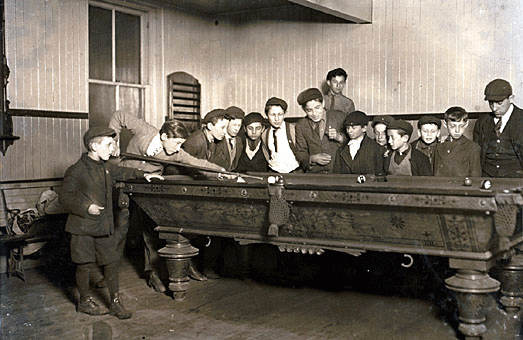
And though the term "pool room" now means a place where people play
pool, it had a very different meaning in the 19th century. Back then a
pool room was a betting parlor for horse racing. Owners installed pool
tables so patrons could pass the time between races.
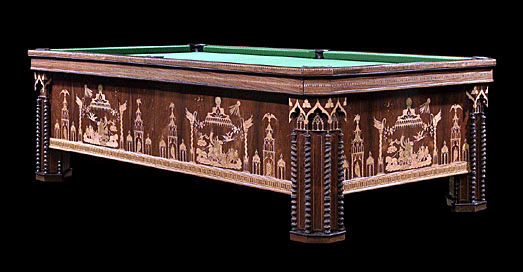
Unfortunately, "pool halls" began to get a bad name and this reputation
slowly dimmed the lights on the honorable game of billiards. Hundreds of
them began to falter and close across the country in the 1930s and
1940s. Many politicians were advocating the closure of billiard rooms in
an attempt to "clean up their communities" as part of their campaign
platforms, all the while playing billiards in the homes of their
upper-class constituents.
Billiard Terms
It’s good for players and collectors to have a working understanding of
some basic billiard terms. First, a “billiard” table was one without
pockets while “pocket billiard” tables had none. Players also used the
term "carom table" in the early days of the sport to denote a billiard
table without pockets. Snooker is similar to pocket billiards but is
typically played on a somewhat larger table with considerably smaller
pocket openings and smaller balls. It’s a much harder game, often
enjoyed by more skilled players. Then to confuse things even more, the
term “pool” has come to be a generic term for all of these games.
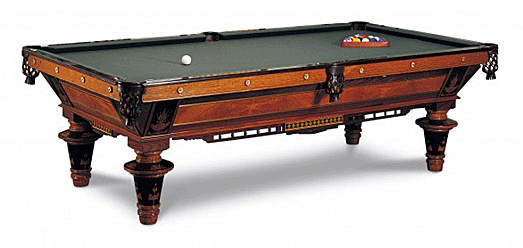
Nearly every major billiard table manufacturer published a set of rules
in an attempt to universalize the way the game was to be played
professionally. Serious players ordinarily opted for the largest table
their home's billiard room would accommodate. In the early 1800s, the
two typical table sizes used for the majority of sanctioned tournament
play were a 5 x 5 feet. In these early years, players considered a
9-foot table an embarrassment, and those who owned a 7 or 8-foot table
were wise to keep it to themselves.
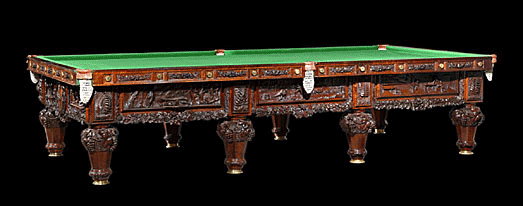
Tournament prizes ranged from hundreds to even thousands of dollars.
There were spectacular keepsakes such as magnificent and monstrous
sterling-silver trophies and beautiful silver or gold watches with
intricate billiard scenes engraved on them. Even the incredible and
exotic billiard tables specially created for the national and
international competitions were awarded to the proud victors. The
national and world champions became the celebrities of their time.
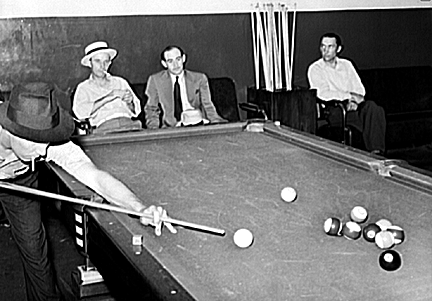 In
the U.S. the dominant American billiard game until the 1870's was
American Four-Ball Billiards, usually played on a large (11 or 12-foot),
four-pocket table with four billiard balls - two of them white and two
red. This was a direct extension of English Billiards. Points were
scored by pocketing balls, scratching the cue ball, or by making caroms
on two or three balls. With many balls, there were many different ways
of scoring and it was possible to make up to 13 pints on a single shot.
American Four-Ball produced two offspring, both of which surpassed it in
popularity by the 1870's. One of the games, known as "straight rail,”
used simple caroms played with three balls on a pocketless table. The
other popular game was American Fifteen-Ball Pool, the predecessor of
modern pocket billiards. In
the U.S. the dominant American billiard game until the 1870's was
American Four-Ball Billiards, usually played on a large (11 or 12-foot),
four-pocket table with four billiard balls - two of them white and two
red. This was a direct extension of English Billiards. Points were
scored by pocketing balls, scratching the cue ball, or by making caroms
on two or three balls. With many balls, there were many different ways
of scoring and it was possible to make up to 13 pints on a single shot.
American Four-Ball produced two offspring, both of which surpassed it in
popularity by the 1870's. One of the games, known as "straight rail,”
used simple caroms played with three balls on a pocketless table. The
other popular game was American Fifteen-Ball Pool, the predecessor of
modern pocket billiards.
While the memorabilia from this field is amazingly diverse, finding
early items isn't easy. It takes persistence, great patience and
sometimes deep pockets to put together a collection.
<
Back to Antiques Archives
Next Article > |
